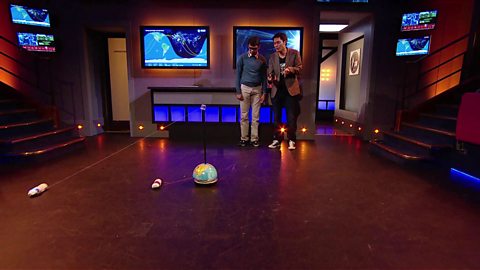This clip opens with British Space Scientist, Monica Grady, commentating live from Kazakhstan during the launch of the Soyuz rocket carrying Tim Peake into orbit.
She points out that the rocket turns east at a certain altitude.
Back in the Royal Institution lecture theatre, Dr Kevin Fong uses a student to demonstrate how the rotation of the Earth provides rockets with additional kinetic energy to help them reach escape velocity.
In order to make the most of this, rockets need to travel through the atmosphere towards the east after launch, aligned with the direction that the Earth rotates in.
This clip is from the Royal Institution Christmas Lectures 2015.
Teacher Notes
This clip could be used to challenge students to explain why the rocket is launched vertically, before turning to travel east through the atmosphere.
Students could plan an investigation into the effects of launching rockets from a moving or rotating launch site.
They could use fizzing film canister rockets for this.
Curriculum Notes
This clip will be relevant for teaching KS3 and GCSE Physics.
This topic appears in OCR, Edexcel, AQA, WJEC KS4/GCSE in England and Wales, CCEA GCSE in Northern Ireland and SQA National 4/5 in Scotland.
More from the Royal Institution Christmas Lectures 2015
What is Newton's Cannon and Third Law? video
Dr Kevin Fong demonstrates projectile motion, orbit and Newton’s Third Law.

How the vacuum of space affects the human body. video
Dr Kevin Fong does a demonstration to show the lethal effects of a vacuum on the human body.

Resonant Frequency. video
Dr Kevin Fong explains how sound vibrations could pose a real threat astronauts and rockets in space.

Orbital Rendezvous. video
Dr Kevin Fong demonstrates how and why it's so hard for a spacecraft to catch up with the International Space Station.

What does gas weigh? video
A demonstration that carbon dioxide can be poured because it is denser than air.

Why are bones weaker in orbit? video
Kevin Fong explains how micro-gravity can weaken bones. Models are used to show that bones are strong but light, and how low gravity weakens them.

How micro-gravity disorientates us. video
A demonstration of how dizziness occurs during motion sickness or micro-gravity.

The danger of orbital debris. video
Dr Kevin Fong and NASA astronaut Dan Tani explain the danger of space debris.

Demonstrating heat shield material. video
Dr Kevin Fong explains that space capsules heat up due to pressure not friction. He demonstrates a heat shield’s low thermal conductivity.

Why Earth rock is found on the Moon. video
Dr Kevin Fong demonstrates how debris from meteorites hitting Earth threw Earth rock as far as the Moon, leaving clues there about Earth’s geological history.

Demonstrating radiation detectors. video
Dr Kevin Fong shows how a Geiger-Muller tube can detect ionising radiation but not the type of radiation, and how detectors on the International Space Station can.

How Earth protects us from radiation. video
Dr Kevin Fong discusses the dangers to astronauts of solar radiation, and how we’re protected from it by Earth’s atmosphere and magnetic field.

Why tardigrades can survive in orbit. video
Dr Kevin Fong explains why tardigrades are so resilient when exposed to ionising radiation lethal to most other organisms.

How to recycle urine in space. video
Dr Kevin Fong demonstrates a urine recycling system that works using osmosis, concluding by drinking the liquid that is produced.

Ã˝